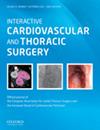Repair with a pulmonary neovalve in tetralogy of Fallot: does this avoid ventricular dysfunction?
IF 1.6
4区 医学
Q3 CARDIAC & CARDIOVASCULAR SYSTEMS
引用次数: 0
Abstract
Abstract OBJECTIVES Given the anatomical variations of tetralogy of Fallot (TOF), different surgical techniques can be used to achieve correction. Transannular patches (TAPs) are the most commonly used technique; they are associated with right ventricular dysfunction, the incidence of which can be reduced through pulmonary valve preservation. METHODS Between January 2010 and July 2019, we performed 274 surgical corrections of tetralogy of Fallot at Fundación Cardioinfantil; 63 patients (23%) underwent repair with a TAP in addition to a pulmonary neovalve (Group I), 66 patients (24.1%) received a TAP without a pulmonary valve (Group II) and 145 patients (52.9%) had a repair with valve preservation (Group III). We analysed patient’s characteristics before, during and after surgery at a 30-day follow-up. RESULTS We found that patients in Group III were older (P = 0.04). Group II had the lowest level of O2 saturation before surgery (82%, P = 0.001). Cardiopulmonary bypass and aortic cross-clamp times were longer in Group I (P < 0.001). Right ventricular dysfunction was less frequent in Group III (15.9%, P = 0.011). Severe residual pulmonary regurgitation was more common in Group II (21.9%, P = 0.001). CONCLUSIONS Preservation of the pulmonary valve is an important factor for immediate postoperative management of tetralogy of Fallot. Patients who were repaired with a TAP with or without a pulmonary neovalve had a higher incidence of right ventricular dysfunction than those with pulmonary valve preservation.法洛四联症的肺新瓣膜修复:能避免心室功能障碍吗?
摘要目的考虑到法洛四联症(TOF)的解剖差异,可以采用不同的手术技术来实现矫正。经环补片(TAPs)是最常用的技术;它们与右心室功能障碍有关,可通过保留肺动脉瓣来降低其发生率。方法:2010年1月至2019年7月,我们在Fundación Cardioinfantil进行了274例法洛四联症的手术矫正;63例患者(23%)接受了除肺新瓣膜外的TAP修复(I组),66例患者(24.1%)接受了不带肺瓣膜的TAP (II组),145例患者(52.9%)接受了保留瓣膜的修复(III组)。我们在30天的随访中分析了患者术前、术中和术后的特征。结果III组患者年龄较大(P = 0.04)。II组术前血氧饱和度最低(82%,P = 0.001)。I组体外循环和主动脉交叉夹夹时间较长(P < 0.001)。第三组右心功能不全发生率较低(15.9%,P = 0.011)。严重残余肺返流在II组更为常见(21.9%,P = 0.001)。结论保存肺动脉瓣是法洛四联症术后立即处理的重要因素。与保留肺瓣膜的患者相比,有或没有肺新生瓣膜的TAP患者右室功能障碍的发生率更高。
本文章由计算机程序翻译,如有差异,请以英文原文为准。
求助全文
约1分钟内获得全文
求助全文
来源期刊

Interactive cardiovascular and thoracic surgery
CARDIAC & CARDIOVASCULAR SYSTEMS-
CiteScore
3.30
自引率
0.00%
发文量
292
审稿时长
2-4 weeks
期刊介绍:
Interactive CardioVascular and Thoracic Surgery (ICVTS) publishes scientific contributions in the field of cardiovascular and thoracic surgery, covering all aspects of surgery of the heart, vessels and the chest. The journal publishes a range of article types including: Best Evidence Topics; Brief Communications; Case Reports; Original Articles; State-of-the-Art; Work in Progress Report.
 求助内容:
求助内容: 应助结果提醒方式:
应助结果提醒方式:


